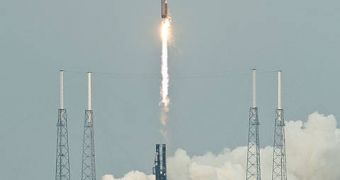Following the successful orbital insertion of the Lunar Reconnaissance Orbiter (LRO) space probe on a trajectory around the Moon yesterday, NASA announced that the Lunar Crater Observation and Sensing Satellite (LCROSS) also successfully completed the most important part of its early flight stages. The satellites swung by the Moon offer a real-time feed of the Earth's natural satellite via NASA TV. The maneuver placed the probe and its spent Centaurus rocket stage on an orbit that will allow LCROSS to study the permanently shadowed craters on the Moon's poles.
“With the assist of the moon's gravity, LCROSS and its attached Centaur booster rocket successfully entered into polar Earth orbit at 6:20 am PDT [1320 GMT] on June 23rd. The maneuver puts the spacecraft and Centaur on course for a pair of impacts near the moon's south pole on October 9th,” a press release on the American space agency's official website reveals.
“The successful completion of the LCROSS swing-by proves the science instruments are functioning as expected. It is a testament to the hard work and dedication of the entire team. We are elated at the results from the maneuver and eagerly anticipate the impacts in early October,” the LCROSS Project Manager, Dan Andrews, says. He is currently working out of NASA's Ames Research Center, in Moffett Field, California.
With the new fly-by, the probe also activated its scientific instruments, whose goal will be to analyze the cloud of debris that is formed when the spent Centaurus rocket stage hits the lunar soil in one of the shadow craters, and blasts dirt and sand up. The researchers who designed the spacecraft, worth more than $70 million dollars, say that its sensitive devices would then analyze the light coming through the dust, and look for signs of liquid or frozen water. Their hopes of finding something in the craters are high, because some of these formations have remained shadowed and away from sunlight for more than two billion years.
“Each instrument returned good data that the science team will spend the next few weeks analyzing. These data will ensure we are as prepared as possible for monitoring and interpreting data we receive during impact,” LCROSS Project Scientist Anthony Colaprete, also from the Ames Center, adds.

 14 DAY TRIAL //
14 DAY TRIAL //